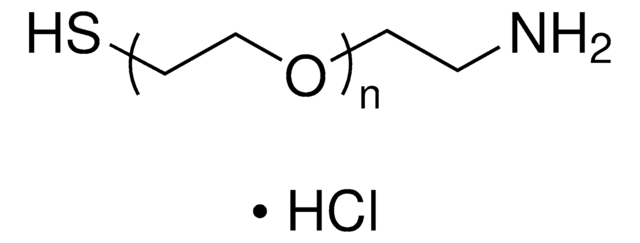757810
Poly(ethylene glycol) 2-mercaptoethyl ether acetic acid
average Mn 1,000 (n~22), cross-linking reagent amine reactive, cross-linking reagent thiol reactive
Sinónimos:
Polyethylene glycol, mercaptoPEG acid, mercaptopoly(ethylene glycol) carboxylic acid, mercaptopolyoxyethylene acetic acid, thio-PEG, thiol-PEG-acid, thiol-PEG-carboxylate
About This Item
Productos recomendados
product name
Poly(ethylene glycol) 2-mercaptoethyl ether acetic acid, average Mn 1,000
form
solid
mol wt
PEG average Mn 1,000 (n~22)
average Mn 1,000
reaction suitability
reagent type: cross-linking reagent
reactivity: amine reactive
reagent type: cross-linking reagent
reactivity: thiol reactive
transition temp
Tm 40-45 °C
Ω-end
thiol
α-end
carboxylic acid
polymer architecture
shape: linear
functionality: heterobifunctional
storage temp.
−20°C
¿Está buscando productos similares? Visita Guía de comparación de productos
Application
- bioconjugation
- drug delivery
- PEG hydrogel
- crosslinker
- surface functionalization
Storage Class
11 - Combustible Solids
wgk_germany
WGK 3
flash_point_f
>604.4 °F
flash_point_c
> 318 °C
Elija entre una de las versiones más recientes:
¿Ya tiene este producto?
Encuentre la documentación para los productos que ha comprado recientemente en la Biblioteca de documentos.
Los clientes también vieron
Artículos
The use of hydrogel-based biomaterials for the delivery and recruitment of cells to promote tissue regeneration in the body is of growing interest. This article discussed the application of hydrogels in cell delivery and tissue regeneration.
Devising biomaterial scaffolds that are capable of recapitulating critical aspects of the complex extracellular nature of living tissues in a threedimensional (3D) fashion is a challenging requirement in the field of tissue engineering and regenerative medicine.
Nuestro equipo de científicos tiene experiencia en todas las áreas de investigación: Ciencias de la vida, Ciencia de los materiales, Síntesis química, Cromatografía, Analítica y muchas otras.
Póngase en contacto con el Servicio técnico







![O-(3-Carboxypropyl)-O′-[2-(3-mercaptopropionylamino)ethyl]-polyethylene glycol Mw 3000](/deepweb/assets/sigmaaldrich/product/structures/271/277/d02536f0-83d7-4416-9cea-f6213e09fe85/640/d02536f0-83d7-4416-9cea-f6213e09fe85.png)


![[11-(Methylcarbonylthio)undecyl]tetra(ethylene glycol) 95%](/deepweb/assets/sigmaaldrich/product/structures/287/466/ac954604-0c13-45a1-bacf-9fd872709839/640/ac954604-0c13-45a1-bacf-9fd872709839.png)

